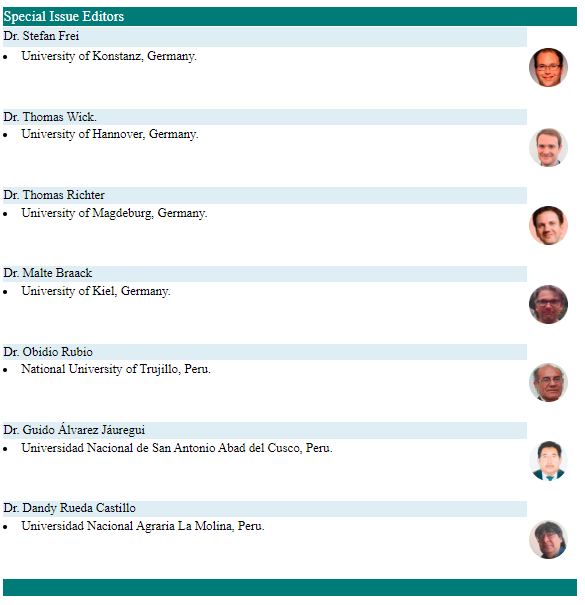Solución Numérica de una Ecuación Diferencial usando el Método de Galerkin y Wavelets B-Splines Cardinales
DOI:
https://doi.org/10.17268/sel.mat.2014.01.01Keywords:
Metodo Galerkin, bases, wavelets, B-splines, Analisis Multiresolución, ED elípticaAbstract
En el presente artculo, resolvemos numericamente una ecuacion diferencial ordinaria elptica con condiciones de frontera tipo Dirichlet. El tratamiento numerico se realiza usando el clasico metodo de Galerkin y un tipo especial de bases wavelets; estas son wavelets B-splines cardinales. Los resultados de la experimentacion numerica realizada muestran que, aun considerando coecientes, y
funcion en el segundo miembro, de la ecuacion diferencial, como funciones discontinuas con salto nito grande, el sistema que se genera es estable si se aplica precondicionamiento y la solucion numerica es sucientemente exacta para bajos niveles de aproximacion.
References
K. Amaratunga, J. Williams, S. Qian y J. Weiss, Wavelet-Galerkin solutions for one dimensional partial dierential equations, IESL Technical Report No. 92-05, Intelligent Engineering Systems Laboratory, M.I.T., 1992.
G. Beylkin, R. Coifman y V. Rokhlin, Fast wavelet transforms and numerical algorithms I, Comm. Pure Appl. Math., 44(1991) pp. 141-183.
H. Brezis, Analisis Funcional, Alianza Editorial S.A., Madrid, 1984.
R. Burgos, R. Silva y M. Santos, Direct solution of dierential equations using the wavelet-Galerkin method, Mecanica Computacional, 29(2010) pp. 4573-4584.
C. Chui y J-Z Wang, On Compactly Spline Wavelets and a Duality Principle, Transactions of the American Mathematical Society, 330 (1992) pp. 903-915.
I. Daubechies, Ten Lectures on Wavelets, SIAM Publications, Philadelphia, 1992.
W. R. Glowinski, W. Lawton, M. Ravachol y E. Tenenbaum, Wavelet solution of linear and nonlinear elliptic, parabolic and hyperbolic problems in one space dimension, Proc. 9th International Conference on Numerical Methods in Applied Sciences and Engineering, SIAM, Philadelphia, 1990.
S. Kesavan, Topics in Functional Analysis and Applications, Wiley Eastern Limited, New Delhi, 1989.
W. Lawton, W. Morrell, E. Tenebaum, y J. Weiss, The wavelet galerkin method for partial dierential equations, Technical Report AD901220, Aware, Inc., 1990.
A. Louis, D. Maass y A. Rieder, Wavelets: Theory and Applications, Johb-Wiley & Sons, USA, 1997.
S. Mallat, A wavelet tour of signal processing, Academic Press, San Diego, 1999.
M. Nair, Wavelet-Galerkin Method, Talk at QIP-short Term Course, Department of Mathematics, IIT Madras, Diciembre, 2004.
H. Nguyen y G. Evangelista, A continuous wavelet-Galerkin method for the linear wave equation [Elektronisk resurs], SIAM Journal on Scientic Computing., 2007
http://liu.diva-portal.org/smash/get/diva2:24195/FULLTEXT01
S. Qian y J. Weiss, Wavelets and the numerical solution of partial dierential equations, Journal of Computational Physics, 106 (1992) pp. 155-175.
K. Urban, Wavelets in Numerical Simulation Problem Adapted Construction and Applications, Ed. Springer, Heilderberg, 2002.
K. Urban, Wavelet Methods for Elliptic Partial Dierential Equations, Oxford Science Publications, Oxford, 2009.
J. Wang, Cubic spline wavelet Bases of Sobolev spaces and multilevel interpolation, Appl. Compu. Harm. Anal., 3 no.2 (1996) pp. 154-163.
R. Wells y X. Zhou, Wavelet Solutions for the Dirichlet Problem, AFOSR Technical Report No. 90-0334, Aware, Inc., 1993.
Downloads
Published
How to Cite
Issue
Section
License
The authors who publish in this journal accept the following conditions:
1. The authors retain the copyright and assign to the journal the right of the first publication, with the work registered with the Creative Commons Attribution License,Atribución 4.0 Internacional (CC BY 4.0) which allows third parties to use what is published whenever they mention the authorship of the work And to the first publication in this magazine.
2. Authors may make other independent and additional contractual arrangements for non-exclusive distribution of the version of the article published in this journal (eg, include it in an institutional repository or publish it in a book) provided they clearly state that The paper was first published in this journal.
3. Authors are encouraged to publish their work on the Internet (for example, on institutional or personal pages) before and during the review and publication process, as it can lead to productive exchanges and to a greater and more rapid dissemination Of the published work.












